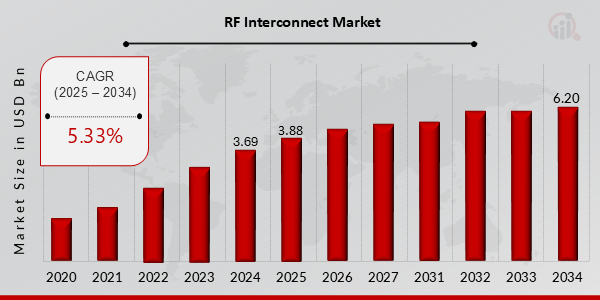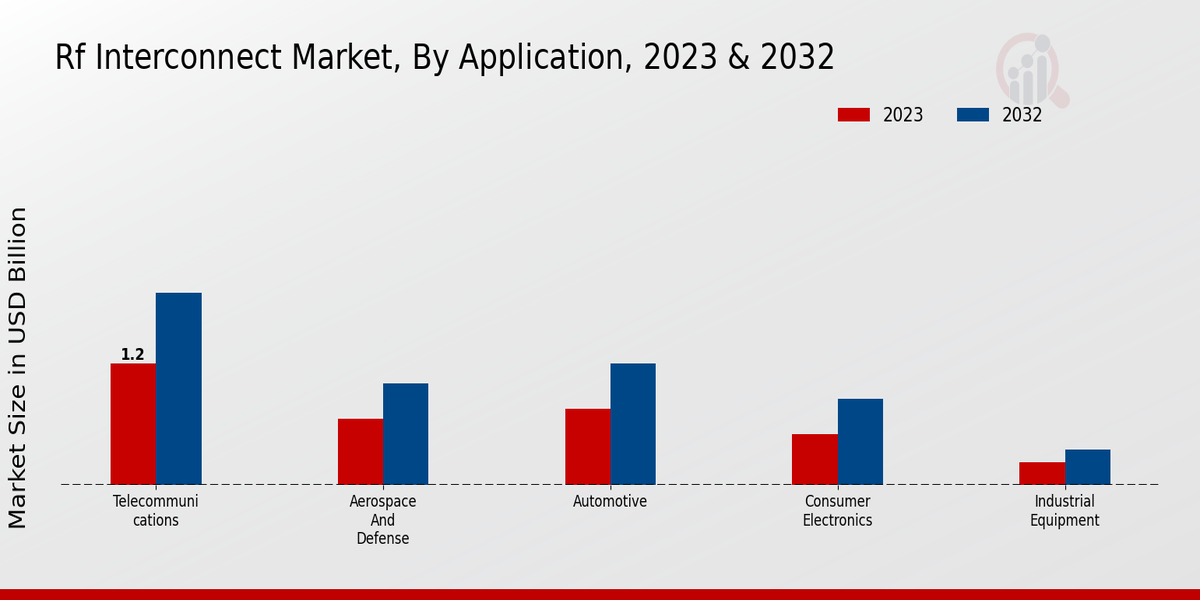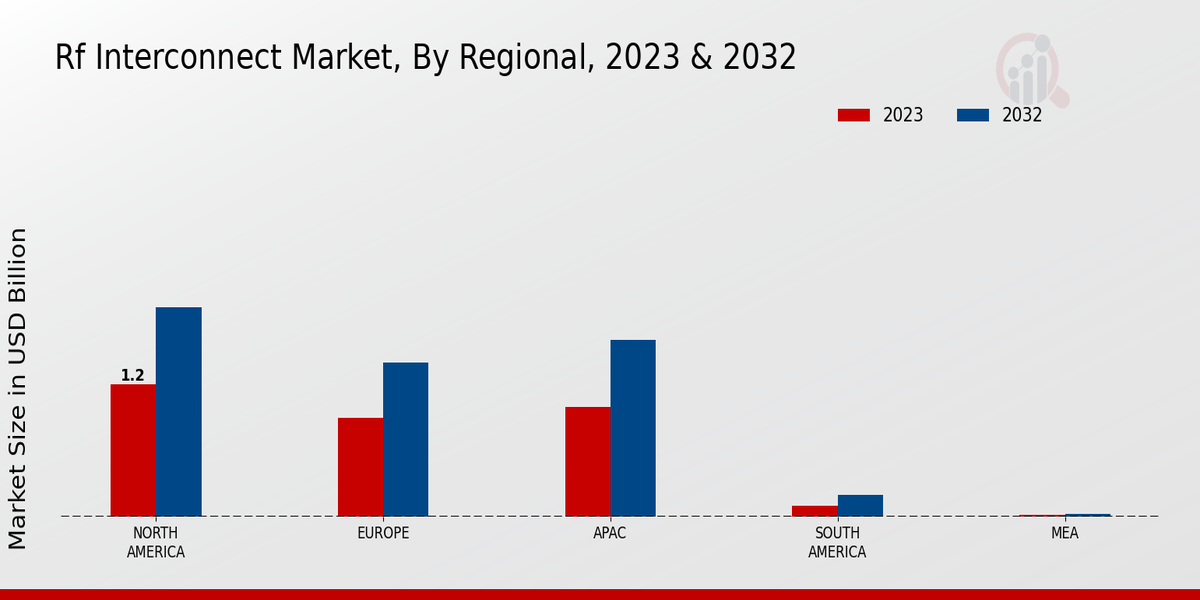Global RF Interconnect Market Overview
RF Interconnect Market Size was estimated at 3.69 (USD Billion) in 2024. The RF Interconnect Market Industry is expected to grow from 3.88 (USD Billion) in 2025 to 6.20 (USD Billion) till 2034, exhibiting a compound annual growth rate (CAGR) of 5.33% during the forecast period (2025 - 2034)
Key RF Interconnect Market Trends Highlighted
The RF Interconnect Market is experiencing key market drivers driven by technological advancements and growing demand for high-frequency communication. The increased adoption of 5G technology is crucial in expanding the need for efficient RF connectors, as these components facilitate better signal integrity and performance. Additionally, the rise in Internet of Things (IoT) devices accelerates market growth as these applications require robust interconnect solutions to ensure seamless connectivity.
There is a strong emphasis on enhancing data transfer speeds and minimizing signal loss, prompting companies to invest in innovative RF interconnect solutions.Opportunities in the market are becoming evident as various industries explore ways to implement more efficient RF interconnects.
The growth of wireless communication networks opens avenues for manufacturers to develop advanced products tailored to the specific requirements of sectors like aerospace, automotive, and telecommunications. Moreover, the increasing focus on miniaturization is driving the demand for compact RF interconnects that can fit into smaller devices while maintaining performance. This presents a chance for players in the market to innovate and cater to user needs effectively.
Trends in recent times indicate a shift towards greater customization and flexibility in RF interconnect solutions.Companies are focusing on developing products that offer higher levels of performance while being adaptable to different environments and applications.
Enhanced manufacturing processes and materials are being explored to improve the durability and reliability of RF interconnects, aligning with the increasing expectations for quality. Furthermore, sustainability is becoming a significant consideration, with manufacturers seeking eco-friendly materials and practices to meet consumer and regulatory demands. In summary, the RF Interconnect Market is poised for significant growth, driven by technological advancements and evolving user needs, creating numerous opportunities for innovation and development.

Source: Primary Research, Secondary Research, MRFR Database and Analyst Review
RF Interconnect Market Drivers
Growing Demand for High-Frequency Applications
The RF Interconnect Market Industry is witnessing a significant increase in demand for high-frequency applications across various sectors, including telecommunications, aerospace, defense, and consumer electronics. This surge can be attributed to the rapid advancements in wireless communication technologies that rely on high-frequency signals for better data transmission and connectivity. With the proliferation of 5G networks and the anticipated rollout of 6G, the need for reliable and efficient RF interconnect solutions is paramount.These advanced technologies require interconnects that can maintain signal integrity and performance at elevated frequencies, enabling faster and more reliable communication.
Moreover, the transition to IoT (Internet of Things) devices further accelerates the need for advanced RF interconnects, as these devices often operate within specific frequency bands and require robust interconnect solutions to meet stringent performance and reliability criteria.Thus, the growing adoption of high-frequency applications fuels the demand for innovative RF interconnect technologies, positioning the market for substantial growth in the coming years.
Technological Advancements in Interconnect Solutions
The RF Interconnect Market Industry is benefitting from continuous technological advancements in interconnect solutions. Innovations such as the miniaturization of components and the use of more efficient materials are enhancing the performance and capabilities of RF interconnects. These advancements lead to the development of products that can handle higher frequencies, reduce signal loss, and improve thermal management. As a result, manufacturers are increasingly focusing on research and development to create next-generation interconnect solutions that cater to the evolving needs of various industries.
Increasing Adoption of Telecommunication Infrastructure
As global communication demands escalate, investments in telecommunication infrastructure are rising. The expansion of broadband services and mobile connectivity is driving the need for high-performance RF interconnects. The RF Interconnect Market Industry is witnessing substantial growth due to the essential role of efficient interconnect solutions in supporting advanced telecommunication systems.
RF Interconnect Market Segment Insights:
RF Interconnect Market Application Insights
The RF Interconnect Market, especially within the Application segment, is poised for significant growth, as illustrated by its projected valuation of 3.32 USD Billion in 2023 and 5.3 USD Billion by 2032. This upward trend underlines the increasing demand for RF interconnect solutions across various industries. The telecommunications sector holds a majority share in the market, with a valuation of 1.2 USD Billion in 2023, expected to rise to 1.9 USD Billion by 2032.
This dominance is primarily due to the ongoing advancements in mobile communication technologies and the push towards higher data rates, which necessitate reliable and efficient RF interconnections. The aerospace and defense segment, valued at 0.65 USD Billion in 2023 and anticipated to reach 1.0 USD Billion in 2032, is also witnessing substantial growth.
The significant investments in satellite communication and radar systems contribute to this upward trajectory, highlighting the essential role of RF interconnects in modern defense systems and aerospace applications. Automotive applications are likewise crucial, beginning at a valuation of 0.75 USD Billion in 2023 and aiming for 1.2 USD Billion by 2032.
The increasing integration of RF solutions for vehicle connectivity, enhanced driver assistance technology, and the development of electric and autonomous vehicles signify the automotive industry's pivotal role in the RF interconnect landscape.In the consumer electronics space, the market is valued at 0.5 USD Billion in 2023, expected to grow to 0.85 USD Billion by 2032. The rising demand for smart devices and high-definition audio/visual equipment drives the necessity for reliable RF interconnect solutions, essential for seamless connectivity.
Lastly, the industrial equipment segment, covering a valuation of 0.22 USD Billion in 2023, projected to grow to 0.35 USD Billion by 2032, reflects the need for RF technology in manufacturing processes and automation applications, where precision and reliability are critical. Collectively, these segments showcase the vibrancy of the RF Interconnect Market, influenced by trends such as the increasing deployment of 5G technology, advancements in the Internet of Things (IoT), and the electrification of transportation. However, the market is not without challenges; factors such as fluctuating material costs and stringent regulations in various industries can hinder growth.
Nevertheless, opportunities abound, particularly in developing advanced RF interconnect technologies that promote efficiency and performance across these applications. The RF Interconnect Market statistics hence affirm that this sector is critical for driving innovation and connectivity across various real-world applications.

Source: Primary Research, Secondary Research, MRFR Database and Analyst Review
RF Interconnect Market Type Insights
In 2023, the RF Interconnect Market is projected to reach a valuation of 3.32 billion USD, reflecting a growing demand for advanced communication technologies. The market showcases a diverse array of types, including Connectors, Cables, Adapters, and Antennas, each playing a vital role in the connectivity within RF applications. Connectors are essential for customizing and securing connections between various RF components, while Cables are critical for signal transmission, ensuring minimal loss.
Adapters facilitate compatibility among different types of devices, which is significant as the integration of technologies continues to expand.Antennas are imperative for effective signal reception and transmission, inherently influencing performance in wireless communications. The RF Interconnect Market data suggests a steady growth trend fueled by increasing demand for wireless communication solutions across various industries, although challenges like maintaining signal integrity persist. Overall, the RF Interconnect Market industry is exhibiting promising market growth driven by innovations and heightened connectivity needs.
RF Interconnect Market Frequency Range Insights
The RF Interconnect Market, valued at 3.32 USD Billion in 2023, is experiencing growth across its Frequency Range segment, which is essential for various applications in communication and broadcasting. This segment features several categories, including Low Frequency, Medium Frequency, High Frequency, and Very High Frequency. The Low-Frequency range plays a crucial role in enabling long-range communications, while the Medium Frequency range is significant for AM radio and maritime communication.
High Frequency is noteworthy for its usage in aviation and shortwave radio, ensuring effective data transmission over considerable distances.In contrast, the Very High-Frequency range dominates in mobile communications and television broadcasting, making it a vital component within the RF Interconnect Market. The increasing demand for wireless communication solutions and advancements in technology are driving market growth across these frequency ranges, highlighting opportunities for innovation and expansion in various sectors. As market dynamics evolve, understanding RF Interconnect Market data and segmentation will be essential for stakeholders to navigate through the competitive landscape effectively.
RF Interconnect Market End Use Insights
The RF Interconnect Market revenue is set to experience a notable growth trajectory, driven primarily by the diverse applications across various end-use sectors. In 2023, the market was valued at 3.32 billion USD, reflecting the increasing demand for efficient communication systems. Among the segments, the commercial sector plays a vital role, accounting for a significant share due to the rising adoption of wireless devices and networking technologies.
Meanwhile, the military segment is equally crucial, as advanced communication technologies are becoming essential for defense operations and secure communications.The telecom infrastructure segment dominates as well, driven by the expansion of mobile networks and the rollout of 5G technologies, which require sophisticated RF interconnect solutions to ensure seamless connectivity. Additionally, the consumer electronics segment continues to grow, supporting the demand for RF interconnects in a range of smart devices. Overall, the trends indicate an ecosystem driven by technological advancements and expanding use cases across these end-use categories, leveraging enhanced communication capabilities.
With a projected market value of 5.3 billion USD by 2032, the future appears promising for stakeholders in the RF Interconnect Market industry, opening up further opportunities for innovation and expansion.
RF Interconnect Market Regional Insights
The RF Interconnect Market is projected to be valued at 3.32 USD Billion in 2023, reflecting a strong regional presence. North America dominates with a valuation of 1.2 USD Billion, growing to 1.9 USD Billion by 2032, indicating its integral role in technological advancements and demand across various sectors. Following North America, Europe holds a significant share at 0.9 USD Billion in 2023 and is expected to reach 1.4 USD Billion by 2032, driven by increased investments in communication technology.
Meanwhile, the APAC region, valued at 1.0 USD Billion in 2023 and set to grow to 1.6 USD Billion by 2032, showcases rapid industrialization and expansion in telecommunications, marking it as a vital player in the market.South America and MEA represent smaller segments, with values of 0.1 USD Billion and 0.02 USD Billion in 2023, respectively, yet they hold potential for growth amidst rising demands for connectivity and infrastructure development.
The classification of the market highlights varying growth trajectories, where North America and APAC lead, while Europe follows closely, underlining the diverse market landscape and opportunities within the RF Interconnect Market.

Source: Primary Research, Secondary Research, MRFR Database and Analyst Review
RF Interconnect Market Key Players and Competitive Insights:
The RF Interconnect Market is characterized by a highly competitive landscape where various players vie for market share through innovative technologies and strategic partnerships. The escalation of demand for high-frequency applications across various industries, including telecommunications, aerospace, and defense, has driven significant advancements in RF interconnect solutions. Competition in this sector encompasses a wide range of product offerings, including connectors, cable assemblies, and adaptors, all designed to ensure high performance and reliability in signal transmission.
With the ongoing evolution of 5G technology and the Internet of Things, companies are increasingly focusing on enhancing their portfolios and operational efficiencies to remain relevant, which leads to diverse strategies being employed by top market players.Pasternack Enterprises has established itself as a formidable presence in the RF Interconnect Market, known for its extensive product range and rapid delivery capabilities.
The company prides itself on maintaining one of the largest inventories of RF and microwave components available for immediate shipment. This operational strength allows Pasternack Enterprises to cater effectively to diverse customer needs across different sectors. Its commitment to quality and innovation sets it apart, as the company continuously invests in R&D to enhance its product offerings and remain at the forefront of technology advancements. Moreover, Pasternack's responsive customer service and technical support further solidify its competitive position, fostering long-lasting relationships with clients.Bel Fuse operates within the RF Interconnect Market with a strong emphasis on delivering high-quality signal integrity solutions.
The company has built a reputation for its expertise in designing and manufacturing various interconnect products, which cater to both communication and electronic applications. Bel Fuse’s strategic focus on product innovation ensures that it consistently meets the rigorous demands of modern RF applications. Additionally, its commitment to sustainability and minimizing environmental impact resonates well with the current market trends, positioning the company favorably among eco-conscious consumers and businesses. As a result, Bel Fuse continues to strengthen its market presence through the effective use of its technological capabilities and a comprehensive understanding of industry needs.
Key Companies in the RF Interconnect Market Include:
Rf Interconnect Market Industry Developments
-
Q4 2024: Amphenol RF launches new IP67-rated FAKRA rear-mount bulkhead plug for high-reliability automotive and industrial applications In December 2024, Amphenol RF introduced a new IP67-rated FAKRA rear-mount bulkhead plug designed for sealed 6 GHz data transmission, targeting high-reliability automotive and industrial applications.
RF Interconnect Market Segmentation Insights
-
RF Interconnect Market Application Outlook
-
RF Interconnect Market Type Outlook
-
RF Interconnect Market Frequency Range Outlook
-
RF Interconnect Market End Use Outlook
-
RF Interconnect Market Regional Outlook
|
Report Attribute/Metric
|
Details
|
|
Market Size 2024
|
USD 3.69 Billion
|
|
Market Size 2025
|
USD 3.88 Billion
|
|
Market Size 2034
|
USD 6.20 Billion
|
|
Compound Annual Growth Rate (CAGR)
|
5.33% (2025-2034)
|
|
Base Year
|
2024
|
|
Market Forecast Period
|
2025-2034
|
|
Historical Data
|
2020-2023
|
| Market Forecast Units |
USD Billion |
|
Report Coverage
|
Revenue Forecast, Competitive Landscape, Growth Factors, and Trends
|
| Key Companies Profiled |
Pasternack Enterprises, Bel Fuse, Amphenol, JAE, Minitron, Samtec, Huber+Suhner, Lcom, RF Industries, AeroFlex, TE Connectivity, Carclo, Rosenberger, Radiall, Molex |
| Segments Covered |
Application, Type, Frequency Range, End Use, Regional |
| Key Market Opportunities |
5G network expansion, Growing IoT devices demand, Aerospace and defense applications, Biomedical device integration, Increased automation in industries |
| Key Market Dynamics |
growing demand for wireless technology, increasing adoption of 5G networks, rising need for high-frequency applications, advancements in automotive electronics, expanding telecommunications infrastructure |
| Countries Covered |
North America, Europe, APAC, South America, MEA |
Frequently Asked Questions (FAQ):
The market is expected to reach a value of 6.20 USD Billion by 2034.
The expected CAGR for the market is 5.33% during the period from 2025 to 2034.
The Telecommunications segment is projected to hold the largest market share, valued at 1.9 USD Billion in 2032.
The Aerospace and Defense application segment is expected to reach 1.0 USD Billion by 2032.
The North American region is expected to be valued at 1.9 USD Billion by 2032.
Key players in the market include Pasternack Enterprises, Amphenol, Bel Fuse, and TE Connectivity.
The Automotive application segment is projected to reach 1.2 USD Billion in 2032.
The Industrial Equipment application is expected to be valued at 0.35 USD Billion in 2032.
Europe is expected to represent a market value of 1.4 USD Billion in 2032.
Challenges include rapid technological advancements and maintaining competitive pricing in the industry.

















